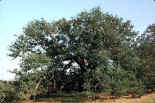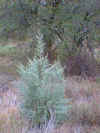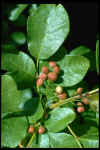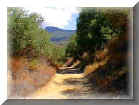Englemann Oak - Quercus
engelmannii Greene
 The
Englemann Oak is another rare species found on our ranch. Its range is limited to Southern
California and it is considered by many to be endangered. It grows from 20 to 50 ft. and
can live up to 200 years old. It is considered deciduous but foliage may persist during
winter. It is considered fire tolerant and is most often found in the foothills below
4,000 ft in elevation. For more information on Southern California oaks see -
http://www.californiaoaks.org/ .
The
Englemann Oak is another rare species found on our ranch. Its range is limited to Southern
California and it is considered by many to be endangered. It grows from 20 to 50 ft. and
can live up to 200 years old. It is considered deciduous but foliage may persist during
winter. It is considered fire tolerant and is most often found in the foothills below
4,000 ft in elevation. For more information on Southern California oaks see -
http://www.californiaoaks.org/ .
Cuyamaca Cypress - T
T
his species of Cypress grows in only one
location in the world, on the Southwest face of Mount Cuyamaca. Ours is located along the
road at the south east entrance to the property. It is a small tree or shrub growing to 20
ft. with cherry red bark and green foliage. According to Bryan Dillow of the
California Native Plants WebSite, "I have found
the Cuyamaca Cypress identified as Cupressus arizonica var.stephensonii from one
source and as Cupressus stephensonii in the CNPS Inventory of Rare and Endangered
Plants of California. The latter source says that it is known from only two
occurrences near Cuyamaca Peak. The CNPS lists it as 1B which is one step away from
extinction due to low numbers and vulnerable habitat."
Fremontia - Fremontodendron
californicum
 Needs excellent drainage and is best growing on
hillsides. It is very drought tolerant which explains why it grows on our ranch.
Native to foothills of Sierra Nevada and Southern California mountains.
Yellow flowers bloom in may through June.
Needs excellent drainage and is best growing on
hillsides. It is very drought tolerant which explains why it grows on our ranch.
Native to foothills of Sierra Nevada and Southern California mountains.
Yellow flowers bloom in may through June.
Coffee Berry -
Rhamnus
californica
 Grows under dry conditions in canyons. coastal and slope habitats.
Native to southwest Oregon, California, Arizona, New Mexico.
Grows under dry conditions in canyons. coastal and slope habitats.
Native to southwest Oregon, California, Arizona, New Mexico.
Poison Oak - Rhus
diversiloba
 This
is one of the more attractive plants on the ranch. It has lush green foliage and its
fall color is more splendid than the sycamores. The Sunset Western Garden Book
describes the leaves as divided into 3 leaflets the edges of which are scalloped, toothed
or lobed.
This
is one of the more attractive plants on the ranch. It has lush green foliage and its
fall color is more splendid than the sycamores. The Sunset Western Garden Book
describes the leaves as divided into 3 leaflets the edges of which are scalloped, toothed
or lobed.
Mule-Fat -
Baccharis
salicifolia
 Occurs under dry conditions in stream bank habitats. Some sources say
the species is limited to lower elevations however ours do fine at 3,500 ft.. It
looses it foliage in the winter.
Occurs under dry conditions in stream bank habitats. Some sources say
the species is limited to lower elevations however ours do fine at 3,500 ft.. It
looses it foliage in the winter.
Yucca whipplei -
 These needle tipped plants are native to southern California
mountains. The flowering stems grow up to 14 ft. long. The Indians used the
course fiber from the foliage to produce baskets and even shoes. This variety is
also called the Mission Bell or Quixote plant.
These needle tipped plants are native to southern California
mountains. The flowering stems grow up to 14 ft. long. The Indians used the
course fiber from the foliage to produce baskets and even shoes. This variety is
also called the Mission Bell or Quixote plant.
Baby Blue Eyes - Nemophila
mensiessii
 To 10 in. tall. Blooms in the spring with a sky blue flower with
whitish center. Mostly in the cooler, shady areas on our ranch.
To 10 in. tall. Blooms in the spring with a sky blue flower with
whitish center. Mostly in the cooler, shady areas on our ranch.
Clarkia - Clarkia
rhomboidea
 Annual that grows in the cool season, blooming in the spring. Ours show
up in shady spots under the oaks and near the creek. I try to hold off my springs
weed whipping until they have gone to seed.
Annual that grows in the cool season, blooming in the spring. Ours show
up in shady spots under the oaks and near the creek. I try to hold off my springs
weed whipping until they have gone to seed.
Sources include, Sunset New Western Garden Book, Bryan Dillow at
California Native Plants
WebSite and UC Berkeley at http://elib.cs.berkeley.edu/photos/.

